#pdf generation software
Explore tagged Tumblr posts
Text
Revolutionizing Workflow: Innovative Desktop Software for Document Generation
In today’s fast-paced business environment, efficiency, consistency, and accuracy are key to success. One of the ways organizations can streamline their operations is by adopting innovative desktop software for document generation. These powerful tools allow businesses to automate the creation of various documents, ranging from contracts and reports to invoices and proposals, all while reducing the chances of human error.
Automating Document Creation for Efficiency
The introduction of innovative desktop software for document generation has drastically simplified the process of creating business documents. Instead of manually inputting data into templates or starting from scratch, these software solutions enable users to generate accurate, pre-filled documents with just a few clicks. This automation not only saves time but also reduces the need for repetitive tasks, allowing businesses to focus on more strategic aspects of their operations.

For instance, many of these tools come equipped with customizable templates, where users can input key details and let the software handle the rest. This means that businesses no longer need to create documents manually, freeing up valuable resources. In industries where documents are crucial, such as legal, finance, or sales, the ability to quickly generate a variety of documents has become a key benefit.
Reducing Errors and Enhancing Accuracy
Manual document creation is prone to errors, especially when dealing with large amounts of data or repetitive tasks. Even small mistakes can result in costly consequences, whether it’s missing a client’s information in a contract or incorrectly listing an amount in a financial report. Innovative desktop software for document generation can eliminate these risks by automatically populating fields and ensuring consistent formatting.
Most of these software tools are equipped with data validation features, which help to catch common mistakes before they become problems. By reducing human intervention, the chances of errors are minimized, leading to a more accurate and reliable document generation process. For businesses dealing with sensitive information, the added layer of accuracy provided by these tools can be invaluable.
Collaboration and Sharing Capabilities
In a business environment, collaboration is key, and innovative desktop software for document generation often includes features that enhance teamwork. Many of these tools allow multiple users to collaborate on the same document, ensuring that team members can contribute and review content in real time. Whether it’s making edits, adding comments, or approving documents, these collaborative features help speed up the review process and improve communication across departments.
Conclusion
Innovative desktop software for document generation is transforming the way businesses approach document creation. By automating repetitive tasks, reducing errors, offering customization, and facilitating collaboration, these tools are providing companies with the means to improve their productivity and accuracy. As organizations continue to embrace digital solutions, adopting advanced document generation software can make a significant difference in streamlining operations and enhancing overall business efficiency. With the right tool, businesses can ensure they are always one step ahead in an increasingly competitive landscape.
#innovative desktop software for document generation#document automation software#desktop document creation tool#document generation solutions#customizable document software#automated document creation#document template software#pdf generation software#document drafting software#document management software#ultimate document management software#user friendly document generation software#estate document planning software
0 notes
Text
Finally got a new charger and my laptop back up and running. We are SO back baby!!!
#I cannot explain how excited I am about this development. I would rather toss my phone into the river 35235 times#than have to live without my stupid little pdfs and movies and writing software#and just in general a screen that I can ACTUALLY see things on and physical keys I can interact with properly#even if it's all entirely offline#it's also just been a fucking nightmare typing anything on here as well#max.txt
8 notes
·
View notes
Text
2 notes
·
View notes
Text
ive been really obsessed with one sheet 8 page minizines recently. there really is nothing like downloading a pdf and printing it out to get a little cut and fold craft project and Right After u get to read a little booklet........magnificent invention
#my familys printer is a little fucked up and has really bad margin cutoffs#(its supposed to be like a normal 1cm margin all around but in practice always forces like 3/4s of an inch to a full inch 😔)#(probably something to do with software or drivers or something) but i dont even mind im just having fun printing out things#i wish more people would put up pdfs for at home minizine printing its so fun#my favourites ive found so far are little games and rpgs#and also i love a good classic informational or personal essay interspersed with images#a few table based generators ive found have also been fun too#a digital zine is fine but i looooove printing things out on a4 paper on my familys fucked up b&w only printer LOL#its fun to hold a little booklet in ur hands and read it!!! its very fun
6 notes
·
View notes
Text

0 notes
Text
Digital on boarding Simplified: the Role of Online Document Creation
In a rapidly changing, remote-ready world, on boarding should not be a scavenger hunt. New employees, customers, and partners all expect digital-first experiences, which should be fast, easy, and painless. This shift to a digital-first experience means that your digital document creator can help organizations streamline manual processes into automated workflows. Whether you’re hiring talent across time zones or on boarding clients in minutes, digital documents help set the stage for what it is like to work with your brand.
0 notes
Text
1 note
·
View note
Text
Helpful Websites & Apps for Writers

A list of helpful websites, apps, and other resources for writers and writing.
Websites for Writers A list of different writing resources, such as online writing communities, research help, free online writing courses, and free writing worksheets.
NaNoWriMo Alternatives A list of different online writing communities and word tracking tools.
Online Writing Communities A tumblr thread with a short list of online writing communities. Includes a writing website for fantasy and science fiction writers, and a website for offering and receiving critique on writing.
Helpful Sites for Writers A short list of helpful resources for writers. Includes websites for character names, an online age calculator, an online height comparison tool, a slang dictionary, and a website to check the weather anywhere in the world.
53 Best Tools for Writers A detailed list of online tools, websites, and apps for writers. Includes both free and paid apps and programs. Note: Please do your research, as a few of the listed websites/apps appear to use generative AI.
Creative Writing Tools A lengthy, detailed list of several resources for writers, including writing apps and programs, online dictionaries, online writing courses, ambient noise websites, image websites, and online PDF tools. Note: Please do your research. There is an entire section of generative AI websites/apps.
The 23 Best Writing Tools of 2025: A Guide for Writers A lengthy, detailed list of different writing programs and apps, online organization and productivity tools, and online editing tools. Includes both free and paid apps and programs. Note: Please do your research, as a few of the listed websites/apps appear to use generative AI.
The Best Book Writing Software A list of different writing programs and apps. Includes both free and paid apps and programs. Each review includes the software’s pros and cons.
For more helpful websites for writers, check out some others I’ve shared: Dictionary & Thesaurus Names for Your Characters Detailed Character Profiles
+
I’m a writer, poet, and editor. I share writing resources that I’ve collected over the years and found helpful for my own writing. If you like my blog, follow me for more resources! ♡
578 notes
·
View notes
Text
Writing Software I Use & Recommend
Brainstorming:
Campfire: Great for organising your thoughts and making detailed character profiles, customised maps, worldbuilding, plot organisation—amongst other features. You can write your manuscript here and post it; and they have many helpful writing tips on their blog. Here's a general overview (customisable):
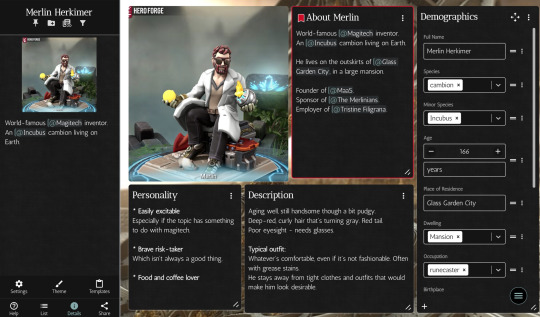
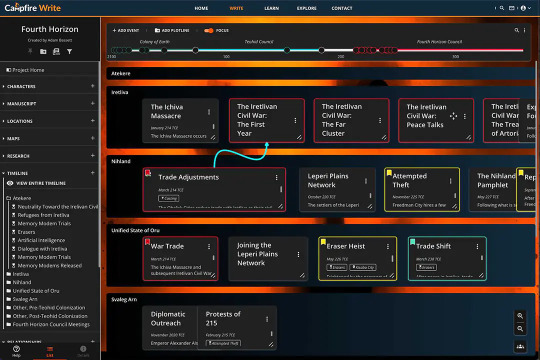
Notion: Although not conventionally a writing software, I find it immensely helpful for getting my thoughts sorted out. It's organised and easy to navigate, and the interface is manageable and uncluttered. (Keep in mind it's hard to cowrite on Notion—if you're planning to, I suggest making a separate Gmail account and both logging in with that.)
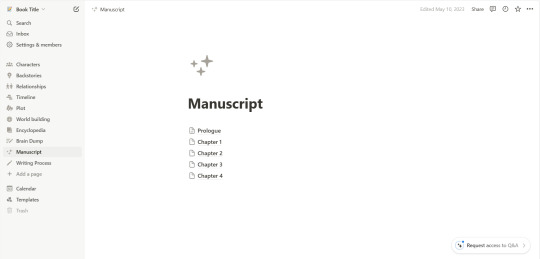
Microsoft Word, with spellcheck off, in Comic Sans (I saw the font thing somewhere and hate that it works). This is what I use when writing excerpts or spontaneous ideas, and it's actually quite effective, though I couldn't tell you why.
Writing/Editing:
Reedsy: The manuscript editor is organised and lets you set writing goals, split chapters, and jot down notes for later. I highly recommend it for authors looking to self-publish—once you're done, you can format and export your book as an eBook or PDF; and you can connect with various editors and find the one that's right for your novel.
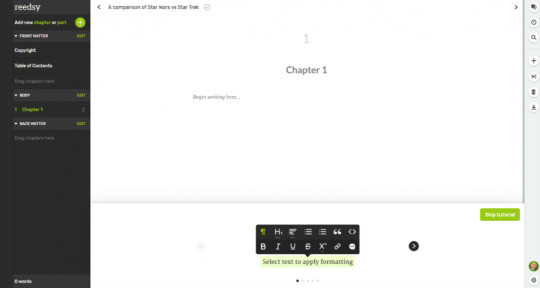
Scrivener: Although, unlike the others I've mentioned so far, this software isn't free, the formatting is great for making an outline, collecting any research and notes, and writing your manuscript.
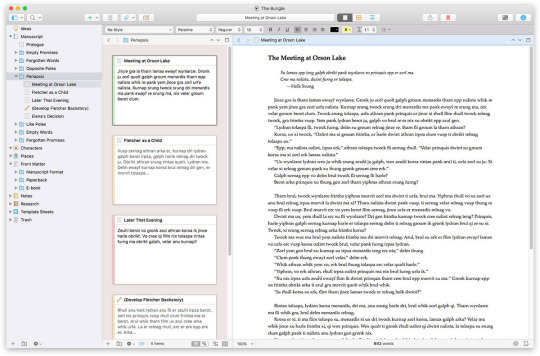
Feel free to add on any more you know of! Hope this was helpful ❤
Previous | Next
#writeblr#writing#writing tips#writing advice#writing help#writing resources#creative writing#writing software#writer stuff#writer help#writing inspiration#deception-united
960 notes
·
View notes
Note
As you've asked for asks!:
Do you have any quick-and-dirty book/fic binding methods a terrified-of-failure novice could use to bang something out to get over the first collywobbling step of Actually Doing The Thing? (this may be something I've been meaning to ask for ages)
yes! I absolutely do! in my opinion the best quick-and-dirty bookbinding method is a no-glue pamphlet: you don't have to mess with glue or measuring or cutting anything, all you need is your text, some paper, a needle and thread. you can use the same needle to punch holes if you don't have an awl.
this is going to be a little long but that's because I'm going to write out some fairly detailed instructions for an A5 sized pamphlet. If you don't want detailed instructions and think you can glean the necessary info from photos, just skip to the photos! I've also linked tutorials.
for preparing the text to printing, in whatever software you use (word, libreoffice, gdocs, whatever) make sure your document is set to page size A5. make it look readable. then save as/export that document as a straight-paged PDF. now go to the bookbinder JS tool (https://momijizukamori.github.io/bookbinder-js/), and upload the PDF. source manipulation: none printer paper size: A4 display unit (you can ignore, or choose cm if it gives you anxiety that it automatically displays points) printer type: select single-sided or duplex accordingly* rotate paper: ignore flip on long side: check if you are printing duplex and if your duplex printer flips the paper on the long side page layout: tick folio page scaling: original page positioning: centered ignore the rest flyfleaf: ignore signature format tick: standard signatures. in the length drop down, this depends on the type of pamphlet you are doing. for folio i generally find 4-5 pages per signature a comfortable thickness. if you have 6 whole A4 pages you can still do that as a single signature or you can split it into two signatures 3 pages each. wacky small layouts: ignore this signature info click the generate preview button to see what your PDF looks like imposed! I love this step especially when I'm doing quarto (A6) or octavo (A7) sized books generate output - click this to generate an imposed PDF
for A6 and A7 sized books the instructions are much the same, except for these you make sure the page size is A6 or A7 in your software, and then you choose quarto or octavo instead of folio. for signature length drop down I keep signature length to 1 for octavos typically and 2 for quartos, as this still refers to sheets of paper, and for octavo 1 sheet of A4 paper will turn into 4 smaller sheets in one signature once folded and cut.
*if you don't have a duplex printer you will have to manually turn the paper to print on the other side. I cannot be arsed with this so I bought a printer capable of duplex printing (I didn't have a printer anyway). if you already have a printer check what it can do as you might be surprised and go from there.
now to the pamphlets! you don't need a cover - I have one for the long stitch pamphlet but for the saddle stitch one I didn't bother and just made sure the first page had a title on it. you can always take a different piece of paper and print a cover on or or just use coloured cardstock and create a simple cover, but a cover is not necessary unless you're doing a long stitch pamphlet. all you need to do is to punch holes and start sewing. there are a few different stitch types below, I wouldn't say any of them are more difficult or easier than others, but they do look different so...pick one you like the look of and go from there?
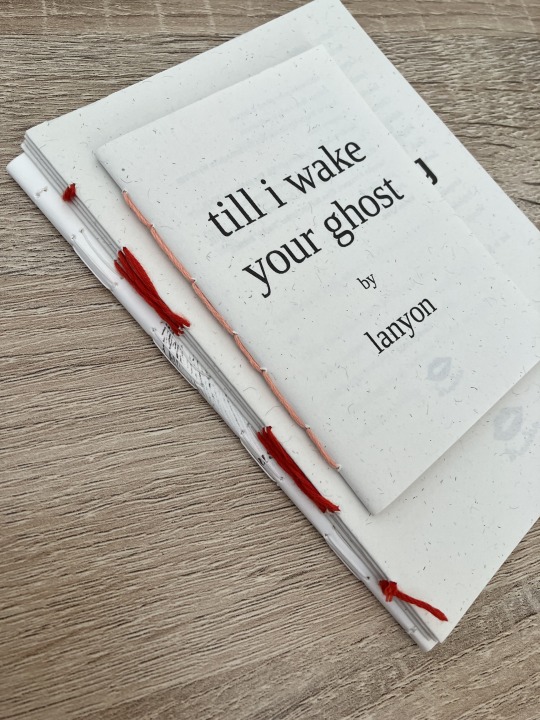
pamphlet stitch (uneven number of holes) I haven't ever done a pamphlet stitch but here's a tutorial for how to do it: https://www.starpointestudio.com/simple-pamphlet-stitch-book-step-by-step/
saddle stitch (uneven number of holes) I realised that what I was thinking of as a pamphlet stitch is actually saddle stitch, as in this A7 pamphlet:
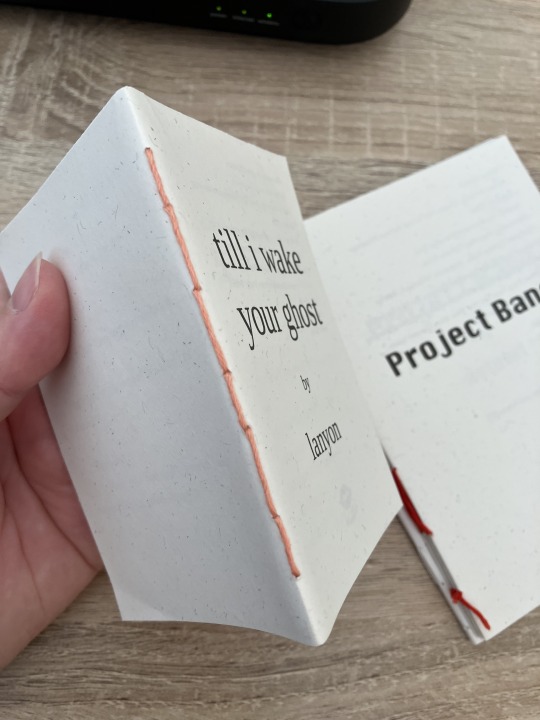
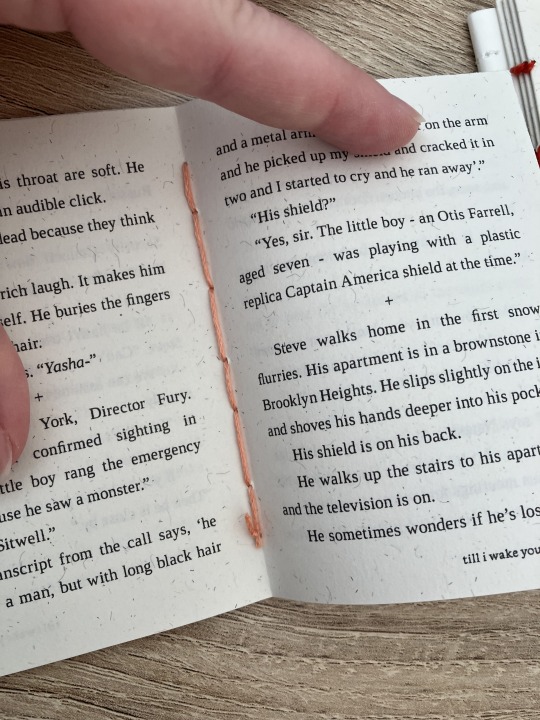
here's a tutorial for how to sew saddle stitch: https://www.bookbindingworkshopsg.com/saddle-stitch-bookbinding-tutorial/ here's a video tutorial: https://www.youtube.com/watch?v=aWHkY5jOoqM (sealemon has a lot of bookbinding tutorials and I know many people who like her videos, I used her tutorial for coptic binding way back when I first made a book but I can't otherwise vouch for the quality as I haven't used her videos)
french link stitch (even number of holes) in this one I used french link stitch which I typically use for thicker textblocks that i'm not planning to use tapes with as the french link gives it some robustness, I used it here because I had never done it before and wanted to try it out. I am planning to take these stitches out and re-sew this pamphlet with a cover now that I've found a suitable piece of transformer fanart to use as a cover:
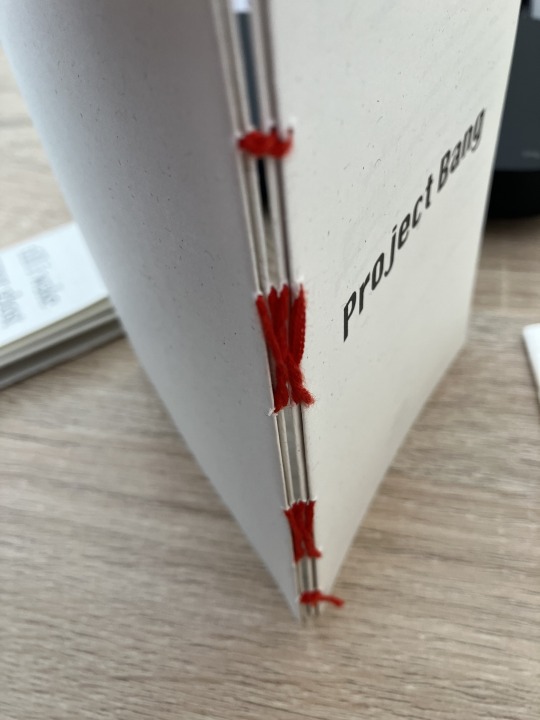
french link tutorial. it's quite long but it has a colour coded bit towards the end that shows how the thread is supposed to link which i find very helpful to visualise: https://www.handmadebooksandjournals.com/bindings/french-link-stitch-binding/
here's a video tutoral from DAS bookbinding (he is my go to for techniques and he has the most soothing Australian accent as well, though fair warning not all of his videos are for beginners): https://www.youtube.com/watch?v=O4ZPdbaM-Ws
long stitch (even number of holes) for this one I used long stitch and I had a cover. this one is my favourite variation because I can make these pretty and simple covers and the stitch looks nice on the outside as well, so this one scratches the 'i want to make a book' itch for me.
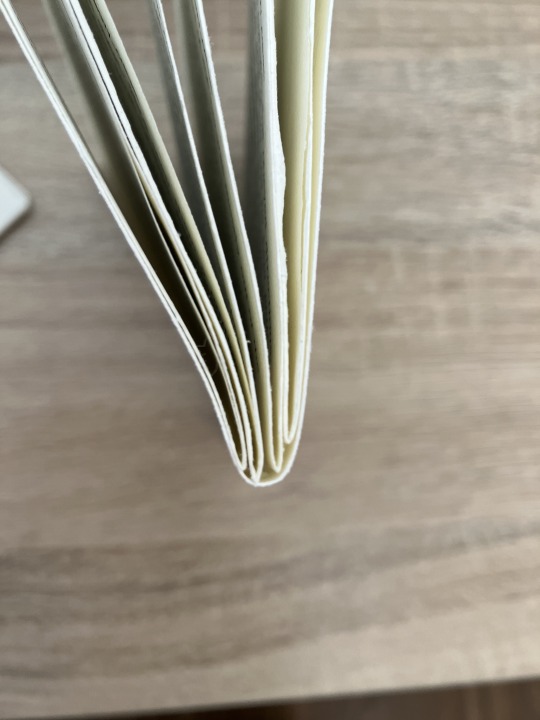
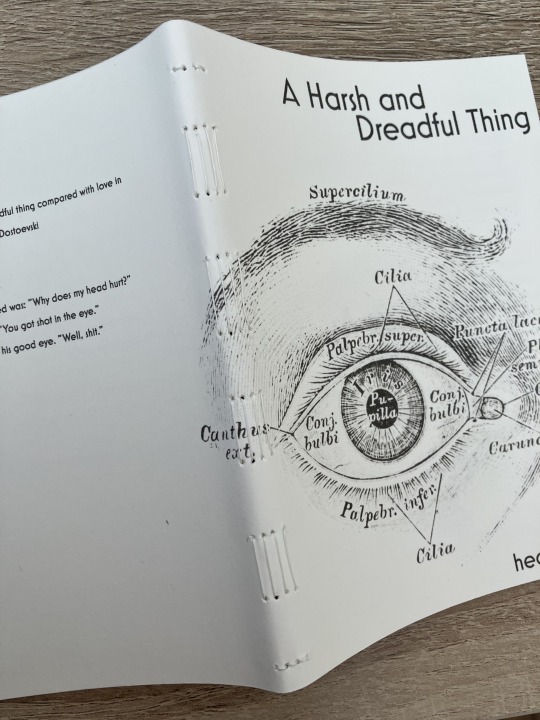
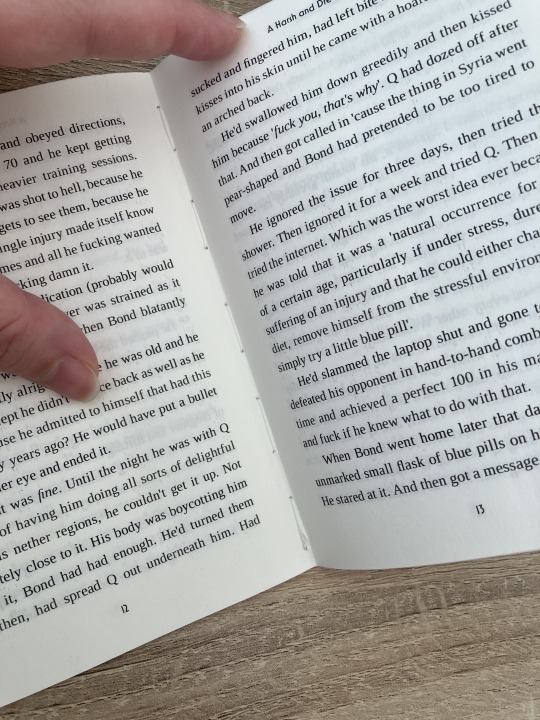
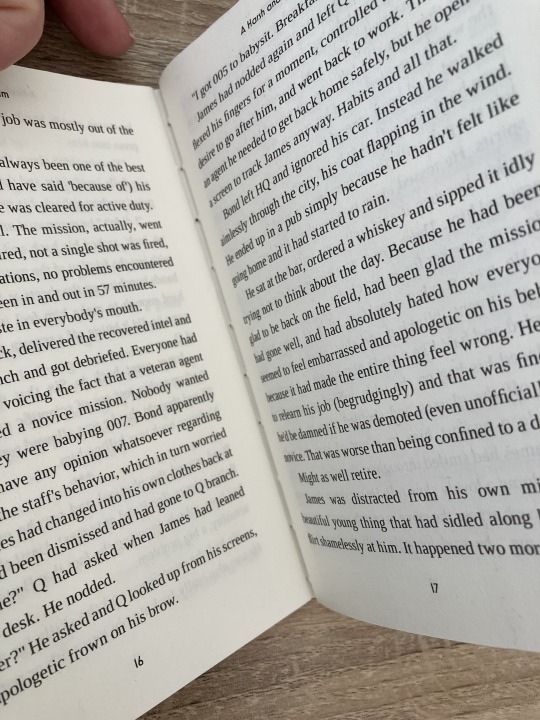
here's a tutorial that also includes a how to on a cover that is different from my cover: https://lccprintmaking.myblog.arts.ac.uk/files/2020/06/Long-Stitch-Tutorial-A4.pdf DAS also has a video tutorial for long stitch but it's like three videos long, maybe watch it later :'D here's one I haven't watched but seems decent: https://www.youtube.com/watch?v=XnignTL_wDQ
you can use saddle stitch for this kind of pamphlet as well, that's what I did for dozens of ships and hundreds of souls (https://ashmouthbooks.tumblr.com/post/681587080267202560).
I hope this helped!!
2K notes
·
View notes
Note
Hii hope your doing well :) so iam writing a character who is blind and has a work but I really don't know how many jobs are there for people with blindness can u list some THANK YOU also I love your blog and the dedication you put in it absolutely helpful glad ur blog exists ♡
Writing Notes: Career Options for Blind Characters
Today’s technology, as well as using different adaptations, allows people with vision loss to do just about any job you can think of. The following list, although not exhaustive, is meant to give a general idea of the different careers and jobs done by people who are blind or visually impaired:
Teachers, college professors and guidance counselors
Social workers and psychologists
Doctors, nurses and occupational and physical therapists
Masseuses and chiropractors
Rehabilitation teachers and counselors
Customer service representatives
Restaurant and store workers
Factory workers
Freelance writers, journalists and TV and radio broadcasters
DJs and musicians
Attorneys, judges and politicians
Executive directors and managers
Coaches and athletes
Authors and motivational speakers
Chefs
Architects
Researchers, engineers and scientists
Artists, musicians and photographers
Just like people with sight, individuals who are blind have different interests and skill sets.
For a long time, the unemployment rate among people with vision loss has been over 70%, and it is due in large part to the numerous misconceptions that still exist.
Thanks to equipment like screen-reading and magnifying software, Braille displays and various other tools, people with vision loss can hold different jobs.
Sources: 1 2 3 4 5 6 7 8 ⚜ More: References ⚜ Writing Resources PDFs
Hi, hope you're doing alright yourself. Thanks so much for your kind words! I love doing these because I also learn so many new things :) You can find more information in the sources linked above (more on writing about workplace accommodations, some common myths). All the best with your writing <3
Writing Notes: Blindness
#anonymous#blindness#writing notes#writing reference#writeblr#literature#dark academia#writers on tumblr#spilled ink#writing prompt#creative writing#light academia#character development#writing inspiration#writing ideas#writing resources
48 notes
·
View notes
Text
“I’m not going to respond to that,” Siri responded. I had just cursed at it, and this was my passive-aggressive chastisement.
The cursing was, in my view, warranted. I was in my car, running errands, and had found myself in an unfamiliar part of town. I requested “directions to Lowe’s,” hoping to get routed to the big-box hardware store without taking my eyes off the road. But apparently Siri didn’t understand. “Which Lowe?” it asked, before displaying a list of people with the surname Lowe in my address book.
Are you kidding me? Not only was the response incoherent in context, but also, only one of the Lowe entries in my contacts included an address anyway, and it was 800 miles away—an unlikely match compared with the store’s address. AI may not ever accomplish all of the things the tech companies say it will—but it seems that, at the very least, computers should be smarter now than they were 10 or 15 years ago.
It turns out that I would have needed an entirely new phone for Siri to have surmised that I wanted to go to the store. Craig Federighi, Apple’s senior vice president of software engineering, said in an interview last month that the latest version of Siri has “better conversational context”—the sort of thing that should help the software know when I’m asking to be guided to the home-improvement store rather than to a guy called Lowe. But my iPhone apparently isn’t new enough for this update. I would need cutting-edge artificial intelligence to get directions to Lowe’s.
This is effectively Apple’s entire pitch for AI. When it launched Apple Intelligence (the company’s name for the AI stuff in its operating systems) last year, the world’s third-most-valuable company promised a rich, contextual understanding of all your data, and the capacity to interact with it through ordinary phrases on your iPhone, iPad, or Mac. For example, according to Apple, you would be able to ask Siri to “send the photos from the barbecue on Saturday to Malia.”
But in my experience, you cannot ask even the souped-up Siri to do things like this.
I embarked on a modest test of Apple Intelligence on my Mac, which can handle the feature. It failed to search my email, no matter how I phrased my command. When I tried to use Siri to locate a PDF of a property-survey report that I had saved onto my computer, it attempted to delegate the task to ChatGPT. Fine. But ChatGPT provided only a guide to finding a survey of a property in San Francisco, a city in which I do not live. Perhaps I could go more general. I typed into Siri: “Can you help me find files on my computer?” It directed me to open Finder (the Mac’s file manager) and look there. The AI was telling me to do the work myself. Finally, I thought I would try something like Apple’s own example. I told Siri to “show me photos I have taken of barbecue,” which resulted in a grid of images—all of which were stock photos from the internet, not pictures from my library.
These limitations are different from ChatGPT’s tendency to confidently make up stories and pass them off as fact. At least that error yields an answer to the question posed, albeit an inaccurate one. Apple Intelligence doesn’t even appear to understand the question. This might not seem like a problem if you don’t use Apple products or are content to rawdog your way to Lowe’s. But it does reveal a sad state of affairs for computing. For years, we’ve been told that frictionless interactions with our devices will eventually be commonplace. Now we’re seeing how little progress has been made toward this goal.
I asked Apple about the problems I’m having with Apple Intelligence, and it more or less confirmed that the product doesn’t work—yet. Apple’s position is that the 2024 announcement, featuring Malia and the cookout, represents a vision for what Siri can and should do. The company expects that work on functionality of this kind will continue into 2026, and it showed me a host of other forthcoming AI tools, including one with the ability to recognize an event in a screenshot of a text message and add the info to a calendar, or to highlight an object in a photo and search for similar ones on Google or Etsy. I also saw a demo of live language translation on a phone call, updated AI-created emoji, and tools to refine what you’ve written inside emails and in Apple software. Interesting, but in my mind, all of these features change how you can use a computer; they don’t improve the existing ways.
After rolling around in my head the idea that Apple Intelligence represents a vision for how a computer should work, I remembered that Apple first expressed this vision back in 1987, in a concept video for a product called Knowledge Navigator. The short film depicts a university professor carrying out various actions of daily and professional life by speaking directly to a personified software assistant on a tablet-like computer—all of the things I long to do with my computer 38 years hence. Knowledge Navigator, per the video, could synthesize information from various sources, responding to a user’s requests to pull up various papers and data. “Let me see the lecture notes from last semester,” the professor said, and the computer carried out the task. While the professor perused articles, the computer was able to identify one by a colleague, find her contact info, and call her upon his request.
Although obscure outside computer-history circles, Knowledge Navigator is legendary in Silicon Valley. It built on previous, equally fabled visions for computing, including Alan Kay’s 1972 proposal for a tablet computer he called DynaBook. Apple would eventually realize the form of that idea in the iPad. But the vision of Knowledge Navigator wasn’t really about how a device would look or feel. It was about what it would do: allow one to integrate all the aspects of a (then-still-theoretical) digital life by speaking to a virtual agent, Star Trek style. Today, this dream feels technologically feasible, yet it is still, apparently, just out of reach. (Federighi promised in the June interview that a better Siri was right around the corner, with “much higher quality and much better capability.”)
Apple Intelligence—really, generative AI overall—emphasizes a sad reality. The history of personal-computer interfaces is also a history of disappointments. At first, users had to type to do things with files and programs, using esoteric commands to navigate up and down the directory structures that contained them. The graphical user interface, which Apple popularized, adapted that file-and-folder paradigm into an abstraction of a desktop, where users would click and move those files around. But progress produced confusion. Eventually, as hard disks swelled and email collected, we ended up with so much digital stuff that finding it through virtualized rummaging became difficult. Text commands returned via features such as Apple’s Spotlight, which allows a user to type the name of a file or program, just as they might have done 50 years ago.
But now the entire information space is a part of the computer interface. The location and route to Lowe’s gets intermixed with people named Lowe in my personal address book. A cookout might be a particular event I attended, or it might be an abstraction tagged in online images. This is nothing new, of course; for decades now, using a computer has meant being online, and the conglomeration of digital materials in your head, on your hard disk, and on the internet often cause trouble. When you’re searching the web, Google asks if you’re perhaps really looking for the thing it deems more common based on other people’s behavior, rather than the thing you typed. And iCloud Drive helpfully uploads your files to the cloud to save disk space, but then you can’t access them on an airplane without Wi-Fi service. We are drowning in data but somehow unable to drink from its wellspring.
In principle, AI should solve this. Services such as ChatGPT, built on large language models that are trained on vast quantities of online and offline data, promised to domesticate the internet’s wilds. And for all their risk of fabrication and hallucination, LLMs really do deliver on that front. If you want to know if there exists a lens with specific properties compatible with a particular model of camera, or seek advice on how to carry out a plumbing repair, ChatGPT can probably be of use. But ChatGPT is much less likely to help you make sense of your inbox or your files, partly because it hasn’t been trained on them—and partly because it aspires to become a god rather than a servant.
Apple Intelligence was supposed to fill that gap, and to do so distinctively. Knowledge Navigator never got built, but it was massively influential within the tech industry as a vision of a computing experience; it shows that Apple has expressed this goal for decades, if under different technological conditions and executive leadership. Other companies, including Google, are now making progress toward that aim too. But Apple is in a unique position to carry out the vision. It is primarily a personal-computer-hardware business focused on the relationship between the user and the device (and their own data) instead of the relationship between the user and the internet, which is how nearly every other Big Tech company operates. Apple Intelligence would make sense of all your personal information and grant new-and-improved access to it via Siri, which would finally realize its purpose as an AI-driven, natural-language interface to all that data. As the company has already done for decades, Apple would leave the messy internet mostly to others and focus instead on the device itself.
That idea is still a good one. Using a computer to navigate my work or home life remains strangely difficult. Calendars don’t synchronize properly. Email search still doesn’t work right, for some reason. Files are all over the place, in various apps and services, and who can remember where? If computationalists can’t even make AI run computing machines effectively, no one will ever believe that they can do so for anything—let alone everything—else.
46 notes
·
View notes
Text
worldbuilding websites list
guides/prompts
Fantasy Worldbuilding Questions - SFWA
Dr. Zahir's Ethnographical Questionnaire - FrathWiki
University of Auntimoany Ethnographical Questionnaire
Creature-Race creation sheet by Sethian-Motzart on DeviantArt
Worldbuilding Bible Template – Ellen Brock
Guide to World Building - Pantheons — Dump Stat Adventures
Building a Pantheon: How to Choose Your Gods - Tribality
Making Gods & Pantheons: Worldbuilding Abstract | Red Ragged Fiend
I invented this world building system for myself, and it's helped me a lot. Posting it here in case it helps somebody else too! (and because mnemonics are rad) : r/worldbuilding
Simple Ideas for Your Solarpunk Worlds : r/worldbuilding
50 Worldbuilding Prompts : r/worldbuilding
A few months ago I posted a not-so-elegant expansion of the 4-elements system, and got tons of truly excellent feedback. Inspired by the exciting discussions from back then, here is version 2.0! CC appreciated :) : r/worldbuilding
TheCosmicForces-WoWChronicleSample.png (PNG Image, 1350 × 1800 pixels) — Scaled (37%)
GitHub - honno/classical-elements-expansion: Because the alchemical elements are so last millennia.
brownlisthumanuniversals.pdf - Google Drive
Worldbuilding: Fantasy Religion Design Guide – Inkwell Ideas
Worldbuilding: Clothing and Fashion | HumanVariant
A Guide to Conworld Architecture : r/worldbuilding
Medieval Bestiary : Contents/SiteMap
kosemen-2017-updated-edition-of-book-all-your-yesterdays.pdf
Political Simulator
A World Building Checklist | Articles | cru’s D&D Reading Room
Split City
Fantasy name generators. Names for all your fantasy characters.
word processors/graph makers/visualizers
TiddlyWiki — a non-linear personal web notebook
bibisco: Best Novel Writing Software for Writers
Preceden Timeline Maker: Create a Timeline in Minutes
Timetoast timeline maker | Timetoast timelines
Free online timeline maker
draw.io
Parliament Diagrams
TreeGraph 2 - A phylogenetic tree editor
Fantasy Calendar - Level up your narrative
Family Echo - Free Online Family Tree Maker
Hero Forge Custom Miniatures
Tennessine
Courtney’s Picrew Zone
Ellipsus | Collaborative writing software
real world inspiration
The Meaning and History of First Names - Behind the Name
Geologic Time Scale - Major Divisions of Geologic Time Chart
Geologic Time Scale v. 6.0 - The Geological Society of America - timescl.pdf
Travel Through Deep Time With This Interactive Earth | Smithsonian
ChronostratChart2023-09 - ChronostratChart2023-09.pdf
ics-chart
International Commission on Stratigraphy
Home - Nationalclothing.org
Folk Fashion Tumblr - Traditional Clothing from the world
Glossary for Medieval Art and Architecture
Heraldry Links-A Free Learning Resource
Flags of the World
Food Timeline: food history research service
History of invention: A science and technology timeline
Medieval Bestiary : Animals in the Middle Ages
Medieval Life
Medievalists.net - Where the Middle Ages Begin
Historical World Maps - World History Atlas
70 notes
·
View notes
Note
Hi, Mr Prokopetz, I'm a big fan. Apologies if you've answered this before, but I was wondering what software you use to create the pdf and epub layouts of your ttrpgs, and whether you'd recommend it to a hobbyist who wants to try putting together something more professional than a gdoc for their own ttrpg?
My workflow is unfortunately not terribly accessible unless you have a fair amount of technical know-how.
In brief, I write all of my games in Notepad++ as HTML documents, taking care to use only the subset of HTML5 tags which are supported by most popular EPUB readers. I then use Calibre (or, more, precisely, the command-line utility that comes with Calibre, though you can get mostly the same results via the GUI) to bundle the HTML document as an EPUB3 file. I typically distribute both the HTML and EPUB versions (the former in a zipfile with all of the fonts and images and such) because web browsers tend to have much better screen-reader support than EPUB apps do.
The PDF, meanwhile, is generated from the same master HTML document using CSS paged media extensions – the layout is all generated automatically based on rules specified in a big, gnarly CSS file, and is never touched by human hands. There are a number of software packages which can do this sort of CSS-driven HTML-to-PDF conversion, some of them free or open source; I use a commercial product called Prince because, to the best of my knowledge, it's the only such software which has out-of-the-box support for PDF/UA semantic tagging (i.e., the stuff you need to do in order to make your PDFs screen-reader friendly), but you have more options if you're willing to tag your PDFs manually. (I am not.)
As for whether I'd recommend doing it this way? Like I said, unless you're a proper gearhead, not really; it's super efficient once you get it all set up – the only version of the game I actually maintain is the master HTML document, and generating updated versions of all the other formats is a one-click affair – but it's really only feasible for me because I already knew how to all that workflow automation stuff for unrelated reasons. I can't imagine teaching yourself all that from scratch just to write elfgames!
349 notes
·
View notes
Text
0 notes
Text
Digital Onboarding Simplified: The Role of Online Document Creation
In a rapidly changing, remote-ready world, onboarding should not be a scavenger hunt. New employees, customers, and partners all expect digital-first experiences, which should be fast, easy, and painless.
This shift to a digital-first experience means that your digital document creator can help organizations streamline manual processes into automated workflows. Whether you’re hiring talent across time zones or onboarding clients in minutes, digital documents help set the stage for what it is like to work with your brand.
Goodbye Paperwork, Hello Personalization
The best online document generation software platforms with smart APIs (such as Sinch APIs) allow organizations to create contracts, forms, agreements, and any policy documents in a few clicks. The beauty is that these documents are smart;they automatically pull in the right names,dates, and custom content based on who is being onboarded.
Do you need an offer letter for a new hire? Or a client onboarding package? Done. No printing, scanning, or PDF version 37b required. Just smart and sleek documents ready to either be signed or shared seamlessly.
Streamlining the Flow
Digital onboarding isn't simply about expediting time; it's reducing friction! Once the onboarding flows are automated and integrated through an online PDF document creator, they can be triggered in real-time (like a signed agreement or email verification).
Welcome emails, onboarding product guides, compliance confirmations, you just auto-generate them. This not only reduces human error but also keeps the process moving while your team sleeps.
More Confidence, Less Chaos
Let’s be real, first impressions matter. When users receive document packages that are clean, on-brand, and relevant, it reflects one thing: we are organized. Trust starts with transparency in industries like finance, healthcare, and tech.
Add audit trails, e-signatures, and secure access control, and you have a process that is more than just simple; it’s smart, compliant, and built for scalability.
The Takeaway
The future is here, and it’s called digital onboarding. The unsung hero, online document creation, is making it possible. It speeds up time to completion, provides a frictionless experience, and creates a polished experience that reflects your brand at its best.
If you’re still sending out Word documents and running down signatures, it’s time to rethink your welcome mat.
0 notes